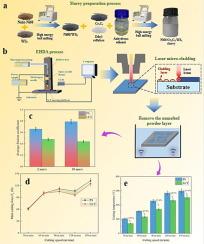当前位置:
X-MOL 学术
›
Appl. Surf. Sci.
›
论文详情
Our official English website, www.x-mol.net, welcomes your
feedback! (Note: you will need to create a separate account there.)
In-situ forming textured cutting tools based on electrohydrodynamic atomization and laser micro-cladding technology
Applied Surface Science ( IF 6.3 ) Pub Date : 2024-11-19 , DOI: 10.1016/j.apsusc.2024.161856 Yichen Bao, Jianxin Deng, Shenghan Cao, Xianshun Sun, Zhihui Zhang, Xujie Tang
Applied Surface Science ( IF 6.3 ) Pub Date : 2024-11-19 , DOI: 10.1016/j.apsusc.2024.161856 Yichen Bao, Jianxin Deng, Shenghan Cao, Xianshun Sun, Zhihui Zhang, Xujie Tang

|
The application of mechanization in different environments has put forward strict requirements for mechanical components, which also means higher requirements for cutting tools. It is precisely these requirements that drive the development of cutting tool preparation methods towards novelty and innovation. To effectively enhance the performance of dry cutting tools, laser micro-cladding technology has been innovatively adopted to achieve additive manufacturing of new textured cutting tools. The mechanical properties, tribological properties, and cutting performance of the newly textured tools were evaluated. The results indicate that the EHDA process can achieve uniformity and thickness controllability of the preset powder layer. In friction experiments, the friction coefficient of textured surfaces can be reduced by up to 44.3% compared to polished surfaces. In the cutting experiment, the cutting force of LCT tools has decreased by up to 26.7%, and the cutting temperature has decreased by a maximum of 32.5%. The research mechanism indicates that at lower cutting speeds, WS2 forms a lubricating film at the tool-chip contact interface, reducing shear strength and achieving a reduction in cutting force and cutting temperature. And the micro-textures are the main way for the LCT tool to reduce cutting force and cutting temperature at higher cutting speeds.
中文翻译:

基于电流流体动力学雾化和激光微熔覆技术的原位成型纹理切削工具
机械化在不同环境中的应用对机械部件提出了严格的要求,这也意味着对切削工具提出了更高的要求。正是这些要求推动了切削刀具制备方法向新颖和创新的方向发展。为了有效提高干式切削工具的性能,创新性地采用了激光微熔覆技术,实现了新型纹理切削工具的增材制造。评估了新纹理工具的机械性能、摩擦学性能和切削性能。结果表明,EHDA 工艺可以实现预设粉末层的均匀性和厚度可控性。在摩擦实验中,与抛光表面相比,纹理表面的摩擦系数最多可降低 44.3%。在切削实验中,LCT 刀具的切削力降低了 26.7%,切削温度最高降低了 32.5%。研究机制表明,在较低的切削速度下,WS2 在刀具-切屑接触界面处形成润滑膜,从而降低剪切强度并降低切削力和切削温度。而微观纹理是 LCT 刀具在较高切削速度下降低切削力和切削温度的主要方式。
更新日期:2024-11-20
中文翻译:

基于电流流体动力学雾化和激光微熔覆技术的原位成型纹理切削工具
机械化在不同环境中的应用对机械部件提出了严格的要求,这也意味着对切削工具提出了更高的要求。正是这些要求推动了切削刀具制备方法向新颖和创新的方向发展。为了有效提高干式切削工具的性能,创新性地采用了激光微熔覆技术,实现了新型纹理切削工具的增材制造。评估了新纹理工具的机械性能、摩擦学性能和切削性能。结果表明,EHDA 工艺可以实现预设粉末层的均匀性和厚度可控性。在摩擦实验中,与抛光表面相比,纹理表面的摩擦系数最多可降低 44.3%。在切削实验中,LCT 刀具的切削力降低了 26.7%,切削温度最高降低了 32.5%。研究机制表明,在较低的切削速度下,WS2 在刀具-切屑接触界面处形成润滑膜,从而降低剪切强度并降低切削力和切削温度。而微观纹理是 LCT 刀具在较高切削速度下降低切削力和切削温度的主要方式。


















































 京公网安备 11010802027423号
京公网安备 11010802027423号